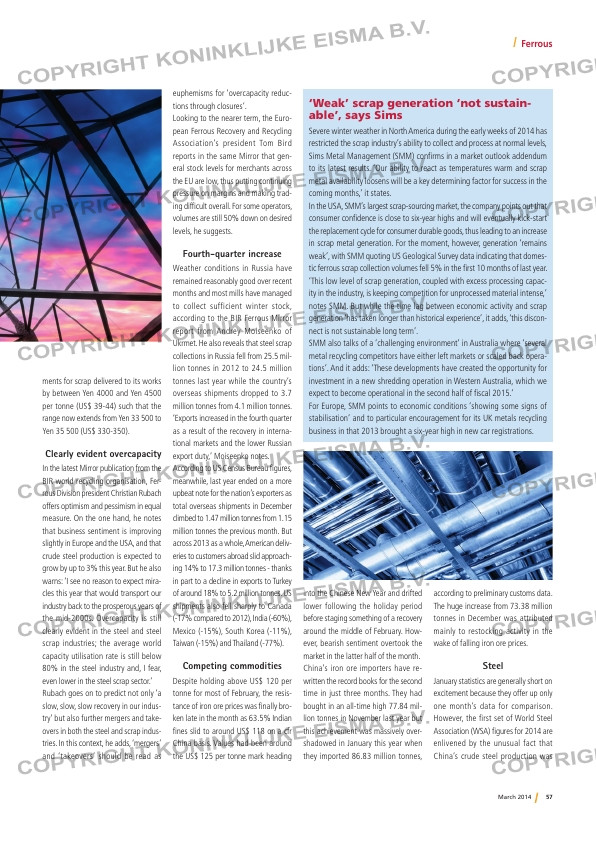Page 57 from: March 2014

57March 2014
Ferrous
ments for scrap delivered to its works
by between Yen 4000 and Yen 4500
per tonne (US$ 39-44) such that the
range now extends from Yen 33 500 to
Yen 35 500 (US$ 330-350).
Clearly evident overcapacity
In the latest Mirror publication from the
BIR world recycling organisation, Fer-
rous Division president Christian Rubach
offers optimism and pessimism in equal
measure. On the one hand, he notes
that business sentiment is improving
slightly in Europe and the USA, and that
crude steel production is expected to
grow by up to 3% this year. But he also
warns: ‘I see no reason to expect mira-
cles this year that would transport our
industry back to the prosperous years of
the mid-2000s. Overcapacity is still
clearly evident in the steel and steel
scrap industries; the average world
capacity utilisation rate is still below
80% in the steel industry and, I fear,
even lower in the steel scrap sector.’
Rubach goes on to predict not only ‘a
slow, slow, slow recovery in our indus-
try’ but also further mergers and take-
overs in both the steel and scrap indus-
tries. In this context, he adds, ‘mergers’
and ‘takeovers’ should be read as
euphemisms for ‘overcapacity reduc-
tions through closures’.
Looking to the nearer term, the Euro-
pean Ferrous Recovery and Recycling
Association’s president Tom Bird
reports in the same Mirror that gen-
eral stock levels for merchants across
the EU are low, thus putting continuing
pressure on margins and making trad-
ing difficult overall. For some operators,
volumes are still 50% down on desired
levels, he suggests.
Fourth-quarter increase
Weather conditions in Russia have
remained reasonably good over recent
months and most mills have managed
to collect sufficient winter stock,
according to the BIR Ferrous Mirror
report from Andrey Moiseenko of
Ukrmet. He also reveals that steel scrap
collections in Russia fell from 25.5 mil-
lion tonnes in 2012 to 24.5 million
tonnes last year while the country’s
overseas shipments dropped to 3.7
million tonnes from 4.1 million tonnes.
‘Exports increased in the fourth quarter
as a result of the recovery in interna-
tional markets and the lower Russian
export duty,’ Moiseenko notes.
According to US Census Bureau figures,
meanwhile, last year ended on a more
upbeat note for the nation’s exporters as
total overseas shipments in December
climbed to 1.47 million tonnes from 1.15
million tonnes the previous month. But
across 2013 as a whole, American deliv-
eries to customers abroad slid approach-
ing 14% to 17.3 million tonnes – thanks
in part to a decline in exports to Turkey
of around 18% to 5.2 million tonnes. US
shipments also fell sharply to Canada
(-17% compared to 2012), India (-60%),
Mexico (-15%), South Korea (-11%),
Taiwan (-15%) and Thailand (-77%).
Competing commodities
Despite holding above US$ 120 per
tonne for most of February, the resis-
tance of iron ore prices was finally bro-
ken late in the month as 63.5% Indian
fines slid to around US$ 118 on a cfr
China basis. Values had been around
the US$ 125 per tonne mark heading
into the Chinese New Year and drifted
lower following the holiday period
before staging something of a recovery
around the middle of February. How-
ever, bearish sentiment overtook the
market in the latter half of the month.
China’s iron ore importers have re-
written the record books for the second
time in just three months. They had
bought in an all-time high 77.84 mil-
lion tonnes in November last year but
this achievement was massively over-
shadowed in January this year when
they imported 86.83 million tonnes,
according to preliminary customs data.
The huge increase from 73.38 million
tonnes in December was attributed
mainly to restocking activity in the
wake of falling iron ore prices.
Steel
January statistics are generally short on
excitement because they offer up only
one month’s data for comparison.
However, the first set of World Steel
Association (WSA) figures for 2014 are
enlivened by the unusual fact that
China’s crude steel production was
‘Weak’ scrap generation ‘not sustain-
able’, says Sims
Severe winter weather in North America during the early weeks of 2014 has
restricted the scrap industry’s ability to collect and process at normal levels,
Sims Metal Management (SMM) confirms in a market outlook addendum
to its latest results. ‘Our ability to react as temperatures warm and scrap
metal availability loosens will be a key determining factor for success in the
coming months,’ it states.
In the USA, SMM’s largest scrap-sourcing market, the company points out that
consumer confidence is close to six-year highs and will eventually kick-start
the replacement cycle for consumer durable goods, thus leading to an increase
in scrap metal generation. For the moment, however, generation ‘remains
weak’, with SMM quoting US Geological Survey data indicating that domes-
tic ferrous scrap collection volumes fell 5% in the first 10 months of last year.
‘This low level of scrap generation, coupled with excess processing capac-
ity in the industry, is keeping competition for unprocessed material intense,’
notes SMM. But while the time lag between economic activity and scrap
generation ‘has taken longer than historical experience’, it adds, ‘this discon-
nect is not sustainable long term’.
SMM also talks of a ‘challenging environment’ in Australia where ‘several
metal recycling competitors have either left markets or scaled back opera-
tions’. And it adds: ‘These developments have created the opportunity for
investment in a new shredding operation in Western Australia, which we
expect to become operational in the second half of fiscal 2015.’
For Europe, SMM points to economic conditions ‘showing some signs of
stabilisation’ and to particular encouragement for its UK metals recycling
business in that 2013 brought a six-year high in new car registrations.
RI-2-2014-MA Ferrous.indd 57 05-03-14 15:06



